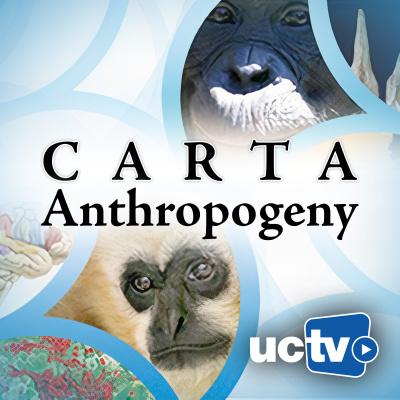Sinopsis
Multidisciplinary researchers explore the origins of humanity and the many facets of what makes us human.
Episodios
-
CARTA: The Biology of Hatred: Why Love Turns to Hatred and What We Can Do About It with Ruth Feldman
14/02/2025 Duración: 20minAncient texts warn of love turning into hatred, as seen in stories like Cain and Abel or “Et tu, Brute?” This talk explores the neurobiology of hatred based on the biology of love: the oxytocin system, attachment networks, and biobehavioral synchrony, which mature through mother-infant bonding and later support group solidarity and out-group hostility. Using this model, we developed Tools of Dialogue© for Israeli and Palestinian youth. After 8 sessions, participants showed reduced hostility, increased empathy, hormonal changes (lower cortisol, higher oxytocin), and lasting attitudes of compromise. Seven years later, these changes supported their peacebuilding efforts, showing how social synchrony can transform hatred into reciprocity and cooperation. Series: "CARTA - Center for Academic Research and Training in Anthropogeny" [Humanities] [Science] [Show ID: 40386]
-
CARTA: How Humans Came to Construct Their Worlds - Questions Answers and Closing Remarks
15/12/2024 Duración: 23minAt a global level, Homo sapiens have reshaped the planet Earth to such an extent that we now talk of a new geological age, the Anthropocene. But each of us shapes our own worlds, physically, symbolically, and in the worlds of imagination. This symposium focuses especially on one form of construction, the construction of buildings, while stressing that such construction is ever shaped by diverse factors from landscape to culture and the construction of history embodied in it - and more. After a brief look at birds building their nests as an example of variation on a species-specific Bauplan, we sample a broad sweep of cultural evolution and niche construction from the earliest stone tools of Neanderthals and Homo sapiens through the Neolithic and the rise of cities to the formal and informal architecture of the present day. Finally, we explore the ways artificial intelligence may further change how humans construct their mental and physical worlds. Series: "CARTA - Center for Academic Research and Training in
-
CARTA: Toward a Smart Architecture of Habitats in the Age of Human-AI Symbiosis in an Eco-Aware World with Michael Fox
13/12/2024 Duración: 22minThe symbolic tools we use to design and construct our environments have been transformed by the so-called Cybernetic revolution and the innovations in materials technology that have accompanied them. The integration of computers, the Internet of Things, embedded robotics, and artificial intelligence (AI) supports the development of intelligent/smart buildings where specific levels of automation can be tailored to every type of building use and occupancy. This talk will emphasize smart architecture as being based on insights into how buildings may affect human well-being whether or not novel technology is employed. This involves a critical assessment of when and where AI and related technologies should be incorporated into the built environment. A complementary concern is with how AI will affect the way humans see their place in their social and "natural" worlds when we can no longer see humans as the only possessors of "intelligence." Series: "CARTA - Center for Academic Research and Training in Anthropogeny
-
CARTA: The Architecture of Informality with Kristine Stiphany
11/12/2024 Duración: 20minThis talk explores the needs of the poor and homeless around the world, charting the interplay between formal and informal settlements. The key example for this talk will be the favelas of Saõ Paulo in the context of a broader concern with Latin American urbanism and the role of individual initiative, social forces and politics as agencies of urban transformation. Built environments are to be seen not only as technological artifacts but also as providing a spatial politics for transforming where and how vulnerable communities immigrate to cities. Key questions arise concerning the relation of informal housing to the formal infrastructural systems of cities, including access to utilities. Series: "CARTA - Center for Academic Research and Training in Anthropogeny" [Humanities] [Science] [Show ID: 40167]
-
CARTA: Göbekli Tepe with Ricarda Braun
01/12/2024 Duración: 17minThe site of Göbekli Tepe is well known as a settlement of the transitional phase in SW-Asia, in which the greater mobility of the Palaeolithic increasingly gave way to the more permanent settlement of the Neolithic. This talk uses the example of Göbekli Tepe to explore the linkage of buildings with ecology, climate, economy, cultural, political, symbolic systems, and creation of networks between dwellings. The central question is to what extent it is possible to understand how people in the Neolithic constructed their world. Based on this, the talk will challenge the regnant hypothesis that Göbekli Tepe served as a central ritual site and meeting place that acted as a driving force for the spread of Neolithization. This provides an important addition to developing a perspective on the precursor forms of habitation for buildings whose architectural remains we can examine today. Series: "CARTA - Center for Academic Research and Training in Anthropogeny" [Humanities] [Science] [Show ID: 40164]
-
CARTA: Deep Time Evolution of the Indigenous Peoples and Architectures of Australia with Paul Memmott
20/11/2024 Duración: 18minThis presentation will briefly trace 70,000 years of cultural evolution from the ancient crossing from Sunda to Sahul, via the swift continental colonization during the Ice Age, through the severe impacts on survival during the Last Glacial Maximum, and the socio-territorial reconfigurations during Holocene sea-level rise. The Australian Aboriginal world had become characterized by low environmental impact habitation, complex social organization systems anchored within constructed sacred origin histories, the persistence of relatively simple dwelling types situated within complex settlement sociospatial structures, and a high quality of life for most, with institutional dispute resolution mechanisms to contain conflicts. Series: "CARTA - Center for Academic Research and Training in Anthropogeny" [Humanities] [Science] [Show ID: 40162]
-
CARTA: How People Learned to Live in Cities with Michael Smith
16/11/2024 Duración: 18minThe transition from Neolithic villages to early cities marked the greatest social transformation faced by our species before the Industrial Revolution. Our ancestors had to learn how to live in new settlements that had more people, higher densities, and more activities than had been known previously. The new adaptations to urban life involved changes in society and social processes, not just individual learning. Some changes came about through social interactions in a process called energized crowding; these include innovations in housing and the use of space, and the establishment of neighborhoods in cities. Other changes were driven by powerful new institutions, including formal governments and social classes. Do ancient cities—and they ways they responded to shocks—might hold useful insights for the development of urban adaptations to climate change today? Series: "CARTA - Center for Academic Research and Training in Anthropogeny" [Humanities] [Science] [Show ID: 40165]
-
CARTA: Evolving the Construction-Ready Brain with Michael Arbib
11/11/2024 Duración: 20minHumans construct their physical worlds in part by designing and constructing new tools, habitations, and in due course diverse buildings and, in some cases, towns and cities and construct their symbolic worlds by putting words together to tell stories, articulate plans, tell lies, seek truth, and much more. This talk offers hypotheses that address a key question for anthropogeny: How did biological evolution yield humans with the “construction-ready brains” and bodies that made us capable of the cultural evolution that created the diversity of our mental and physical constructs that we know today? Series: "CARTA - Center for Academic Research and Training in Anthropogeny" [Humanities] [Science] [Show ID: 40161]
-
CARTA: Combinatorial Technology and the Emergence of the Built Environment with Larry Barham
06/11/2024 Duración: 20minThis talk provides a deep time perspective for assessing the behavioural implications of the creation of the earliest known structure and the technologies used in its making. Evidence for the earliest structure appears relatively late, about 500,000 years ago in Zambia, and before the evolution of Homo sapiens. The next oldest structures were made by Neanderthals in Europe, 176,000 years ago. The site in Zambia preserves rare evidence for the shaping and fitting together of two tree trunks to make a stable framework. The process of combining parts to make a whole reflects a conceptually new approach to technology, one which remains central to everything we make as humans, including structures. Did the invention of combinatorial technology require the use of language to discuss and evaluate diverse ways to form new constructs and constructions? This question arises from the extended planning and expertise needed in the making of combinatorial tools. Series: "CARTA - Center for Academic Research and Training
-
CARTA: How Humans Came to Construct Their Worlds - Welcome and Opening Remarks
29/10/2024 Duración: 09minAt a global level, Homo sapiens have reshaped the planet Earth to such an extent that we now talk of a new geological age, the Anthropocene. But each of us shapes our own worlds, physically, symbolically, and in the worlds of imagination. This symposium focuses especially on one form of construction, the construction of buildings, while stressing that such construction is ever shaped by diverse factors from landscape to culture and the construction of history embodied in it - and more. After a brief look at birds building their nests as an example of variation on a species-specific Bauplan, we sample a broad sweep of cultural evolution and niche construction from the earliest stone tools of Neanderthals and Homo sapiens through the Neolithic and the rise of cities to the formal and informal architecture of the present day. Finally, we explore the ways artificial intelligence may further change how humans construct their mental and physical worlds. Series: "CARTA - Center for Academic Research and Training in
-
CARTA: Bird Nests: Adaptive Variation on Innate Bauplans with Susan Healy
29/10/2024 Duración: 18minAs distinct from the buildings of termites (interesting though these are), bird nests offer a more apropos point of comparison for human buildings – they are conducted by single vertebrate (or a few) and can be adapted to varied circumstances, with even a small effect of social learning. However, the basic Bauplan remains species-specific, unlike the creativity of the human architect. Since nonhuman primates lack interesting building skills, and so we suggest that bird nest construction may come to play a similar comparative role for architectural design. The static Bauplan of birds can be compared to the near-stasis of human tool use until the end of the Paleolithic, challenging us to assess the changes in human practice that unlocked an increasingly rapid process of cultural evolution. Series: "CARTA - Center for Academic Research and Training in Anthropogeny" [Humanities] [Science] [Show ID: 40159]
-
CARTA: Energy in the Balance with Barnabas Calder
25/10/2024 Duración: 20minEvery building – from the Parthenon to the Great Mosque of Damascus to a typical Georgian house – was influenced by the energy available to its architects. This talk offers a historical perspective on a topic of great relevance today, the linkage of architecture and energy. It provides a useful complement to the non-urban perspective on ecology offered by the talk on “The indigenous architecture of Australia.” Architecture has been shaped in every era by our access to energy, from fire to farming to fossil fuels. The talk will discuss a range of buildings of the past fifteen thousand years from Uruk, via Ancient Rome and Victorian Liverpool, to China's booming megacities. If we are to avoid catastrophic climate change one important ingredients is to design beautiful but also intelligent buildings, and to retrofit - not demolish - those that remain. Series: "CARTA - Center for Academic Research and Training in Anthropogeny" [Humanities] [Science] [Show ID: 40166]
-
CARTA: From Cave to Architecture: Settling Down in Southwest Asia with Trevor Watkins
20/10/2024 Duración: 21minHuman "place-making" began over a million years ago when early humans made the hearth the center of social life. By 450,000 years ago, they were using caves in southwest Asia and sometimes buried their dead beneath the floor, linking memory-making with place-making. Hunter-gatherers started settling seasonally around 24,000 years ago, with permanent stone settlements by 13,000 BCE. Large, co-resident communities became common in the Holocene. The Neolithic (9600-6000 BCE) saw major social, economic, and cultural innovations, including architecture, monuments, and symbolic systems. Neolithic societies, with their complex economic relations, proto-urban patterns, and ritualistic architecture, were the first "imagined communities," deeply tied to memory and social symbolism. Series: "CARTA - Center for Academic Research and Training in Anthropogeny" [Humanities] [Science] [Show ID: 40163]
-
CARTA: Lucy - Questions Answers and Closing Remarks
13/10/2024 Duración: 01h19minLucy is one of the most famous fossils of all time. The discovery of this species had a major impact on the science of human origins and evolution. Why? What was that impact? The symposium speakers—each a prominent scientist in their field—will address this question and specifically discuss the discovery’s impact through time, starting with the first few years after the discovery, the lasting impact, and the state of the art in that research area today. We're celebrating the 50th anniversary of the discovery of the fossil skeleton “Lucy” with the aim of reigniting a global interest in how we “became human” and promoting the importance of connecting our human past to the global future on the planet. Series: "CARTA - Center for Academic Research and Training in Anthropogeny" [Humanities] [Science] [Show ID: 39830]
-
CARTA: Naming Lucy: Taxonomic Reasoning in Paleoanthropology with Andra Meneganzin
11/10/2024 Duración: 21minThe discovery of a 3.2-million-year-old hominin skeleton named Lucy revolutionized human evolutionary studies. Her Linnean classification as Australopithecus afarensis sparked debates on taxonomy, highlighting the complexity of interpreting fossil evidence and shaping our understanding of hominin evolution. Lucy's systematics provide insights into the challenges of classifying early hominins, emphasizing how interpretations evolve with new evidence and knowledge. Comparing fossils with living ape taxa and extinct species helps infer evolutionary relationships, while considering temporal variation adds depth to our understanding. Lucy's case illustrates the ongoing debate on species classification in paleoanthropology and the critical role of evidence in shaping taxonomic hypotheses. Series: "CARTA - Center for Academic Research and Training in Anthropogeny" [Humanities] [Science] [Show ID: 39837]
-
CARTA: Fifty Years Since Lucy’s Discovery: Advances in Scientific Knowledge on Human Origins and the Development of African Paleosciences with Yohannes Haile-Selassie
04/10/2024 Duración: 23minLucy, discovered in 1974, revolutionized paleoanthropology, sparking interest in Africa's fossil-rich regions. This led to significant discoveries, pushing human origins records beyond six million years. Lucy's find prompted the establishment of research facilities in Africa, aiding local scholars' training. As we mark her 50th anniversary, we celebrate scientific progress and African research infrastructure while recognizing the need for further support to advance paleosciences in Africa. Series: "CARTA - Center for Academic Research and Training in Anthropogeny" [Humanities] [Science] [Show ID: 39828]
-
CARTA: The First Paleo-Rock Star: Is Lucy Still an Influencer? with Ann Gibbons
27/09/2024 Duración: 21minLucy's 50-year legacy as a superstar in human evolution is undeniable. Yet, with newer, older fossils and a growing understanding of her ancient world, her status as our ancestor is questioned. This talk delves into how these discoveries reshape Lucy's narrative and our understanding of human evolution, likening her to a middle-aged celebrity facing new challengers. Series: "CARTA - Center for Academic Research and Training in Anthropogeny" [Humanities] [Science] [Show ID: 39827]
-
CARTA: Lucy African Heritage and ‘Paleodoms’ with Job Kibii
13/09/2024 Duración: 20minSince Lucy's 1974 discovery, African heritage management and paleoscientific research have evolved significantly. Partnerships with international organizations have supported these efforts, leading to flourishing research and collaborations. However, foreign researchers' access restrictions have hindered efficiency, innovation, collaboration, and diversity. Balancing access restrictions with scientific openness and responsible stewardship is crucial. Series: "CARTA - Center for Academic Research and Training in Anthropogeny" [Humanities] [Science] [Show ID: 39826]
-
CARTA: Lucy’s Contribution: Understanding the Sequence of Steps Leading to Human Uniqueness with Kim Hill
05/09/2024 Duración: 20minHumans are a spectacular outlier among the millions of species of life on planet earth, with incredibly unique biological success. Slowly, scientists have begun to understand the traits that interacted to make us unique, such as cumulative culture, unique scales of cooperation, cognitive abilities, language, and a unique life history and mating system. However, the sequence of evolutionary events that led to our unique species was very much a mystery until the discovery of early bipedal hominins like the australopithecine, Lucy. Here, Kim Hill explains how we have learned so much about this improbable sequence and evolutionary pathway by discovering that early hominins were fully bipedal but still had small brains and little evidence for human mating and life history patterns or cumulative cultural evolution. Lucy helped us understand why the evolution of bipedality was a critical first step that led to an amazing evolutionary sequence that resulted in our spectacular outlier species. Series: "CARTA - Center
-
CARTA: Lucy's Legacy and the Past and Future of Primate Research with Melissa Emery Thompson
31/08/2024 Duración: 19minThe connection between paleoanthropology and primatology began with Darwin's theory of human origins. Lucy's discovery challenged existing ideas, coinciding with observations of wild primates. This sparked a surge of research on primate behavior, enriching our understanding of human evolution. Despite behavior not fossilizing, studying living primates has deepened insights into ancestral lifestyles. By examining their social and ecological dynamics, researchers unravel the origins of complex behaviors like cooperation and culture, shedding light on human adaptations. This interdisciplinary approach has refined methods for studying social processes and their biological effects. Fifty years since Lucy's find, these tools continue to shape our understanding of human evolution and its relevance today. Series: "CARTA - Center for Academic Research and Training in Anthropogeny" [Humanities] [Science] [Show ID: 39824]














